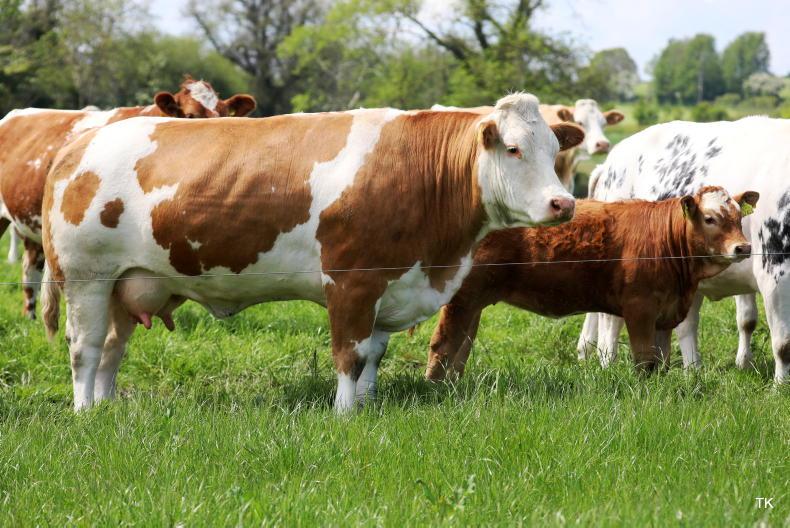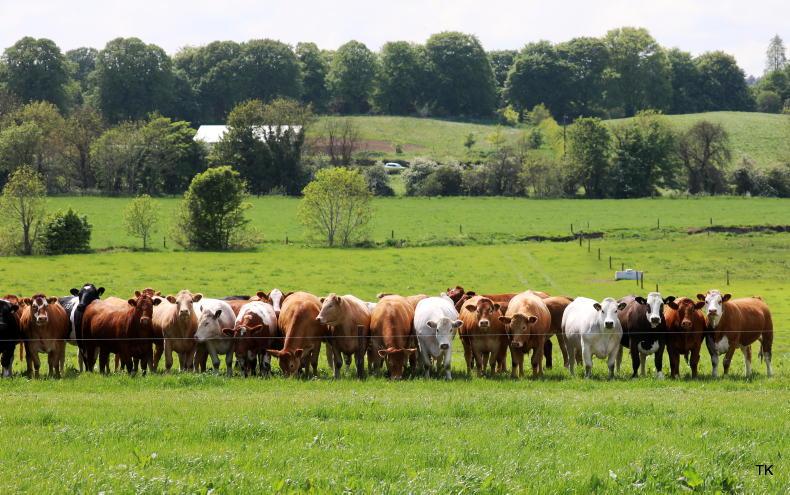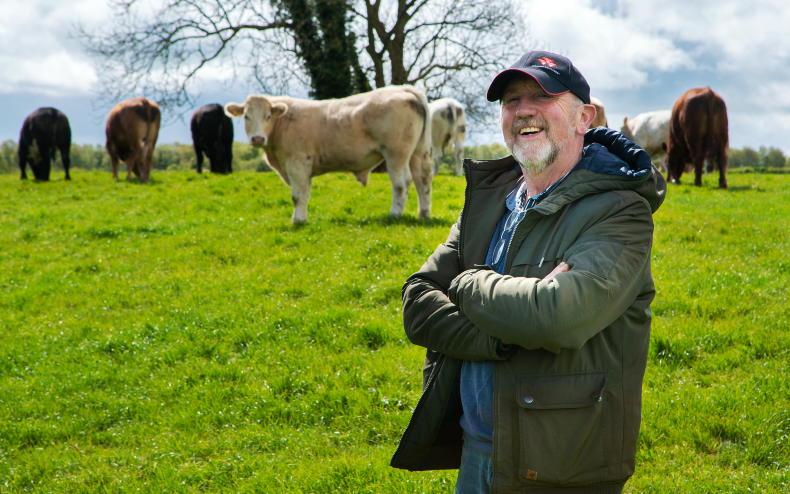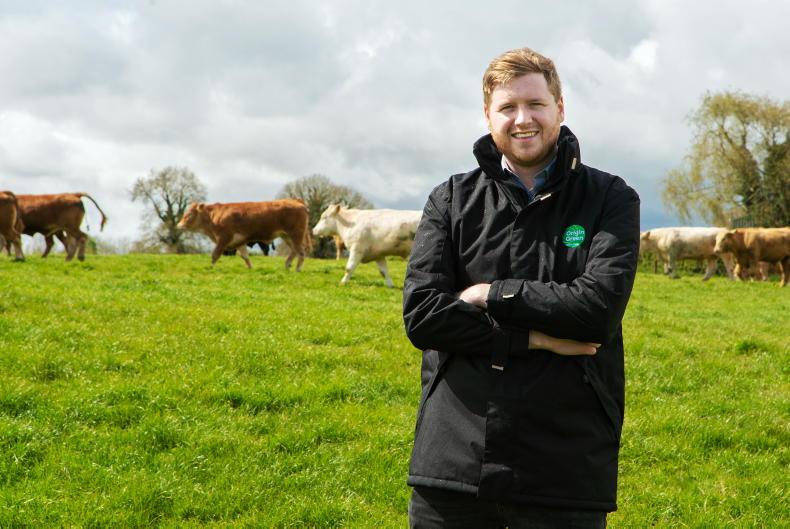The Irish Grassland Association beef conference is always up there as a go-to conference during the year and I can remember some excellent farm visits down through the years which stimulated some really good thought-provoking discussion, arguments and entertainment, something every good farming conference should have in my opinion.
Virtual event
Held virtually on Tuesday night, this year’s conference visited the 1,000-acre Rathmore and Tateetra unit, home to 500 suckler cows, just outside Dundalk in Co Louth.
Viewers also got to get to see inside the farm gate of Allen Callagy, who farms in Kildare purchasing 120 weanlings annually, bringing them through to beef, maximising grass in the diet along the way.
Finally, Rory Mannion from Bord Bia delves a little deeper into the Bord Bia grass-fed standard for Irish beef and how it will work for farmers.
Rathmore and
Tateetra Farms,
Dundalk, Co Louth

John Kingham, Rathmore and Tateetra Farms.
Farm manager: John Kingham
Land: 1,000 acres
Land type: Mainly dry
Cows: 500
Cow type: Limousin/Simmental/Belgian Blue/Shorthorn
System: Suckler to weanling, autumn and spring calving
Labour: Four full-time staff and students
John Kingham grew up on a farm just outside Cullaville on the Monaghan-Armagh border and when he got his chance to take over the management of the Rathmore and Tateetra farms, he took it with both hands.
The unit is owned by the McKeon family of Kilsaran International Ltd and was set up by their father Patrick in the 1960s.
The farm has grown to over 1,000 acres and with continued investment in sheds, it now has the ability to carry over 500 cows.

John Kingham has specialised in the replacement heifer market holding a number of very successful sales already
Prior to John taking over at the farm, all stock were finished.
However, when John took over in September 2017, he saw an opportunity to go down the replacement heifer market: “There is always appetite for that high-quality suckler replacement and I just wanted to try going down that road and it has worked out really well.”
Breeding plan
There are a number of different breeds on the farm, with Limousin, Simmental, Belgian Blue and Shorthorn genetics being used in the last few years.
John said: “The reason we went down this road was to have something for everybody on the farm.
“If I have customers coming on to the farm looking for stock, I want to have something for them, so using different breeds makes sure I do that.”
The farm is using AI on the replacement heifers, with all replacement heifers inseminated to the Dovea Genetics bull Elderberry Galahead (EBY) and then stock bulls after that.
John estimates that about 65% of this year’s heifers are in-calf to AI, with the remainder in-calf to stock bulls.

Cow type on the farm includes Simmental, Limousin, Belgian Blue and Shorthorn.
Limousin, Belgian Blue, Simmental, Charolais and Shorthorn stock bulls are used on the farm.
John said: “We purchased nearly all our bulls in Ireland, with a few across the water and a few in Belgium. My bulls are breeding very well and I’m very happy with them.
“Our last sale averaged €1,350/head for over 150 heifer weanlings, so I think they are doing alright.”
The farm uses a synchronisation programme for the heifers, with John commenting that when you are working big numbers, synchronisation works for them as you don’t have to heat check every day during the breeding period.
He said: “We invested quite heavily in a few good stock bulls in the last 12 months and I wanted to tighten the calving pattern so no cows were AI-ed this year.”
This year sees the first 50 of the farm’s own replacements calve down and John said that will be the plan in the future: “I’ll also pick up a few at shows and sales around the country, I like to give a wee bit back to get a bit.”
The perfect suckler cow
“We are looking for a cow to be quiet, have good feet, have good milk and be able to wean a heavy calf.
“Colour is a big thing at the moment, with roan cattle attracting huge premiums in marts.
“We are trying to breed as many of them as we can but it’s next to impossible to determine what will come. The colour thing is a lot of luck to be honest.
“I also want here to be able to breed a quality calf, so conformation is important.”
Autumn v spring
The farm is looking to move towards more autumn calving in the future.
John said: “I just don’t have the facilities to do it at the minute, but I will have. I want to go to 80% autumn calving. I just feel you have a better calf to sell at the end of the year and you get more from grass with that stronger calf going out in the spring.
“We try to keep things tight. The autumn-calving cows started to calve last year on 1 October and finished up at the end of November, with the spring cows starting in January, with the majority calving by the end of February.”
Grassland management
John said: “When I took over the farm, I installed a lot of paddocks and tried to tighten things up a little.
“Our ground is dry, so if we get very dry weather in summer, we burn up. Once we have rain we can grow a lot of grass.

This year's group of in-calf heifers on the farm.
“We have about 70% of the farm reseeded and that has really helped us in terms of keeping grass in front of cows.”
The farm is split into roughly 2ac paddocks, with cows grazing in groups of 30 cows and 30 calves.
Bulls and heifers are split up from a young age.
“We are trying to eat paddocks in three days and work on a 21-day rotation,” John said.
The future
John has the passion and the drive to keep going and keep producing top-end stock.
He recognises that he is only one cog in the wheel and references the team at Rathmore and Tateetra farms: “A football manager will only bring a football team so far. You need the right players and I feel I have the right players here to make things work.”
Allen Callagy, Moyvalley, Co Kildare

Beef finisher Allen Callegy.
Farm size: 150 acres
Animal numbers: 120 male weanlings purchased every year
Farm system: Weanling to beef
Breeds: Continental weanlings
Land type: Mixed
Allen Callagy runs a weanling to beef system on his farm just outside Moyvalley on the Meath-Kildare border. He purchases in 120 weanlings every year and brings them through to beef at 24 to 27 months.
He places a huge emphasis on purchasing management.
“When the calves come in, I like to house them for three days. It just settles them in and gets them used to me.
I have to be careful not to increase that stress on my farm
“I like to keep them in the batches they come to the farm in. I buy 15 to 20 weanlings a week and keep them in small groups for a few weeks until they are well settled in.
“It’s a very stressful time on animals, coming off the cow, coming through the mart, so I have to be careful not to increase that stress on my farm.”
Finishing system
Allen is trying to finish more and more animals off grass as opposed to the shed, as he feels it’s a lot cheaper to finish off grass.
The average carcase weight for his continental bullocks is around 410kg, with some going back to grass and coming in a little bit heavier.
Grassland management
Allen said: “Five or six years ago, I was just set stocking cattle, putting 20 cattle in a field and leaving them there for the summer, but I changed things around a bit in recent years and I now have 42 grazing divisions on the farm, up from 13 divisions a few years ago.
I was able to finish my cattle a month earlier this year
“This has really increased the quality of the grass the cattle are grazing because you are cleaning each paddock every time and I see this in the weight gains of the cattle.
“As a result of this, I was able to finish my cattle a month earlier this year and that’s a serious cost saving for my farm.”
A solar unit that powers a pump to service the farm with water and an electric fence to split fields was central in implementing paddock grazing and it also allowed Allen fence all cattle out of watercourses on his farm.
Allen also put a focus on soil fertility, spreading P, K and lime rather than reseeding, and this has really helped grass production on the farm.
It’s a great way of reducing costs
“Some of our pastures are 25 years old and just by correcting soil fertility on these paddocks we have really increasing the grass growing potential of them,” he said.
This has also helped Allen make better-quality silage, with 74 DMD silage being made on the farm for the last few years.
“It’s a great way of reducing costs, we’ve been able to hit 0.6kg/day for periods where no meal has been fed so the aim is to try and reduce meal consumption even more on the farm.
“I’ve been able to reduce meal usage by 40% over the last two years on the farm.”
‘Market intelligence would tell us that customers want grass-fed beef and more importantly are willing to pay a premium for that beef’

Rory Mannion, Bord Bia
The Bord Bia grass-fed beef standard is a processor-level standard whereby data is analysed as part of the Bord Bia Quality Assurance audit to determine whether the animals on that farm qualify for grass fed status.
Herds must be a member of the Bord Bia beef and lamb assurance scheme (SBLAS).
Assessment of conformity must be completed using the Bord Bia grass-fed model and the assessment must be completed using data from the SBLAS audit. Information required for the operation of the grass-fed standard must be available for the animal’s whole life.
Eligible animals
Meat from eligible animals must only be classified as grass-fed if 90% of their diet has been grass or grass forage.
The animal must also spend at least 220 days at grass in any year, with a 40-day leniency available for wet years.
The first nine months of an animal’s life is not included in the calculations.
Rory Mannion said: “Market intelligence would tell us that customers want grass-fed beef and more importantly are willing to pay a premium for that beef.
“It’s very early days with the standard and we are currently looking at ways of how that premium could be passed back through the supply chain to primary producers.”
Since 1 January 2021 there have been over 265,000 animals queried, with 73% of these qualifying for grass-fed status.
Of these qualified animals, 97% of their diet was grass-based.
Having the data to back up this standard is a major strength that we have
Farmers wishing to qualify for the scheme need to make sure that they retain their quality-assured status and that if purchasing animals that they are coming from a quality assured herd.
The model currently includes cows, heifers, steers and young bulls.
“Having the data to back up this standard is a major strength that we have over our competitors and hopefully it will open up more markets for us in the future” he said.
The Irish Grassland Association beef conference is always up there as a go-to conference during the year and I can remember some excellent farm visits down through the years which stimulated some really good thought-provoking discussion, arguments and entertainment, something every good farming conference should have in my opinion.
Virtual event
Held virtually on Tuesday night, this year’s conference visited the 1,000-acre Rathmore and Tateetra unit, home to 500 suckler cows, just outside Dundalk in Co Louth.
Viewers also got to get to see inside the farm gate of Allen Callagy, who farms in Kildare purchasing 120 weanlings annually, bringing them through to beef, maximising grass in the diet along the way.
Finally, Rory Mannion from Bord Bia delves a little deeper into the Bord Bia grass-fed standard for Irish beef and how it will work for farmers.
Rathmore and
Tateetra Farms,
Dundalk, Co Louth

John Kingham, Rathmore and Tateetra Farms.
Farm manager: John Kingham
Land: 1,000 acres
Land type: Mainly dry
Cows: 500
Cow type: Limousin/Simmental/Belgian Blue/Shorthorn
System: Suckler to weanling, autumn and spring calving
Labour: Four full-time staff and students
John Kingham grew up on a farm just outside Cullaville on the Monaghan-Armagh border and when he got his chance to take over the management of the Rathmore and Tateetra farms, he took it with both hands.
The unit is owned by the McKeon family of Kilsaran International Ltd and was set up by their father Patrick in the 1960s.
The farm has grown to over 1,000 acres and with continued investment in sheds, it now has the ability to carry over 500 cows.

John Kingham has specialised in the replacement heifer market holding a number of very successful sales already
Prior to John taking over at the farm, all stock were finished.
However, when John took over in September 2017, he saw an opportunity to go down the replacement heifer market: “There is always appetite for that high-quality suckler replacement and I just wanted to try going down that road and it has worked out really well.”
Breeding plan
There are a number of different breeds on the farm, with Limousin, Simmental, Belgian Blue and Shorthorn genetics being used in the last few years.
John said: “The reason we went down this road was to have something for everybody on the farm.
“If I have customers coming on to the farm looking for stock, I want to have something for them, so using different breeds makes sure I do that.”
The farm is using AI on the replacement heifers, with all replacement heifers inseminated to the Dovea Genetics bull Elderberry Galahead (EBY) and then stock bulls after that.
John estimates that about 65% of this year’s heifers are in-calf to AI, with the remainder in-calf to stock bulls.

Cow type on the farm includes Simmental, Limousin, Belgian Blue and Shorthorn.
Limousin, Belgian Blue, Simmental, Charolais and Shorthorn stock bulls are used on the farm.
John said: “We purchased nearly all our bulls in Ireland, with a few across the water and a few in Belgium. My bulls are breeding very well and I’m very happy with them.
“Our last sale averaged €1,350/head for over 150 heifer weanlings, so I think they are doing alright.”
The farm uses a synchronisation programme for the heifers, with John commenting that when you are working big numbers, synchronisation works for them as you don’t have to heat check every day during the breeding period.
He said: “We invested quite heavily in a few good stock bulls in the last 12 months and I wanted to tighten the calving pattern so no cows were AI-ed this year.”
This year sees the first 50 of the farm’s own replacements calve down and John said that will be the plan in the future: “I’ll also pick up a few at shows and sales around the country, I like to give a wee bit back to get a bit.”
The perfect suckler cow
“We are looking for a cow to be quiet, have good feet, have good milk and be able to wean a heavy calf.
“Colour is a big thing at the moment, with roan cattle attracting huge premiums in marts.
“We are trying to breed as many of them as we can but it’s next to impossible to determine what will come. The colour thing is a lot of luck to be honest.
“I also want here to be able to breed a quality calf, so conformation is important.”
Autumn v spring
The farm is looking to move towards more autumn calving in the future.
John said: “I just don’t have the facilities to do it at the minute, but I will have. I want to go to 80% autumn calving. I just feel you have a better calf to sell at the end of the year and you get more from grass with that stronger calf going out in the spring.
“We try to keep things tight. The autumn-calving cows started to calve last year on 1 October and finished up at the end of November, with the spring cows starting in January, with the majority calving by the end of February.”
Grassland management
John said: “When I took over the farm, I installed a lot of paddocks and tried to tighten things up a little.
“Our ground is dry, so if we get very dry weather in summer, we burn up. Once we have rain we can grow a lot of grass.

This year's group of in-calf heifers on the farm.
“We have about 70% of the farm reseeded and that has really helped us in terms of keeping grass in front of cows.”
The farm is split into roughly 2ac paddocks, with cows grazing in groups of 30 cows and 30 calves.
Bulls and heifers are split up from a young age.
“We are trying to eat paddocks in three days and work on a 21-day rotation,” John said.
The future
John has the passion and the drive to keep going and keep producing top-end stock.
He recognises that he is only one cog in the wheel and references the team at Rathmore and Tateetra farms: “A football manager will only bring a football team so far. You need the right players and I feel I have the right players here to make things work.”
Allen Callagy, Moyvalley, Co Kildare

Beef finisher Allen Callegy.
Farm size: 150 acres
Animal numbers: 120 male weanlings purchased every year
Farm system: Weanling to beef
Breeds: Continental weanlings
Land type: Mixed
Allen Callagy runs a weanling to beef system on his farm just outside Moyvalley on the Meath-Kildare border. He purchases in 120 weanlings every year and brings them through to beef at 24 to 27 months.
He places a huge emphasis on purchasing management.
“When the calves come in, I like to house them for three days. It just settles them in and gets them used to me.
I have to be careful not to increase that stress on my farm
“I like to keep them in the batches they come to the farm in. I buy 15 to 20 weanlings a week and keep them in small groups for a few weeks until they are well settled in.
“It’s a very stressful time on animals, coming off the cow, coming through the mart, so I have to be careful not to increase that stress on my farm.”
Finishing system
Allen is trying to finish more and more animals off grass as opposed to the shed, as he feels it’s a lot cheaper to finish off grass.
The average carcase weight for his continental bullocks is around 410kg, with some going back to grass and coming in a little bit heavier.
Grassland management
Allen said: “Five or six years ago, I was just set stocking cattle, putting 20 cattle in a field and leaving them there for the summer, but I changed things around a bit in recent years and I now have 42 grazing divisions on the farm, up from 13 divisions a few years ago.
I was able to finish my cattle a month earlier this year
“This has really increased the quality of the grass the cattle are grazing because you are cleaning each paddock every time and I see this in the weight gains of the cattle.
“As a result of this, I was able to finish my cattle a month earlier this year and that’s a serious cost saving for my farm.”
A solar unit that powers a pump to service the farm with water and an electric fence to split fields was central in implementing paddock grazing and it also allowed Allen fence all cattle out of watercourses on his farm.
Allen also put a focus on soil fertility, spreading P, K and lime rather than reseeding, and this has really helped grass production on the farm.
It’s a great way of reducing costs
“Some of our pastures are 25 years old and just by correcting soil fertility on these paddocks we have really increasing the grass growing potential of them,” he said.
This has also helped Allen make better-quality silage, with 74 DMD silage being made on the farm for the last few years.
“It’s a great way of reducing costs, we’ve been able to hit 0.6kg/day for periods where no meal has been fed so the aim is to try and reduce meal consumption even more on the farm.
“I’ve been able to reduce meal usage by 40% over the last two years on the farm.”
‘Market intelligence would tell us that customers want grass-fed beef and more importantly are willing to pay a premium for that beef’

Rory Mannion, Bord Bia
The Bord Bia grass-fed beef standard is a processor-level standard whereby data is analysed as part of the Bord Bia Quality Assurance audit to determine whether the animals on that farm qualify for grass fed status.
Herds must be a member of the Bord Bia beef and lamb assurance scheme (SBLAS).
Assessment of conformity must be completed using the Bord Bia grass-fed model and the assessment must be completed using data from the SBLAS audit. Information required for the operation of the grass-fed standard must be available for the animal’s whole life.
Eligible animals
Meat from eligible animals must only be classified as grass-fed if 90% of their diet has been grass or grass forage.
The animal must also spend at least 220 days at grass in any year, with a 40-day leniency available for wet years.
The first nine months of an animal’s life is not included in the calculations.
Rory Mannion said: “Market intelligence would tell us that customers want grass-fed beef and more importantly are willing to pay a premium for that beef.
“It’s very early days with the standard and we are currently looking at ways of how that premium could be passed back through the supply chain to primary producers.”
Since 1 January 2021 there have been over 265,000 animals queried, with 73% of these qualifying for grass-fed status.
Of these qualified animals, 97% of their diet was grass-based.
Having the data to back up this standard is a major strength that we have
Farmers wishing to qualify for the scheme need to make sure that they retain their quality-assured status and that if purchasing animals that they are coming from a quality assured herd.
The model currently includes cows, heifers, steers and young bulls.
“Having the data to back up this standard is a major strength that we have over our competitors and hopefully it will open up more markets for us in the future” he said.












 This is a subscriber-only article
This is a subscriber-only article










SHARING OPTIONS: